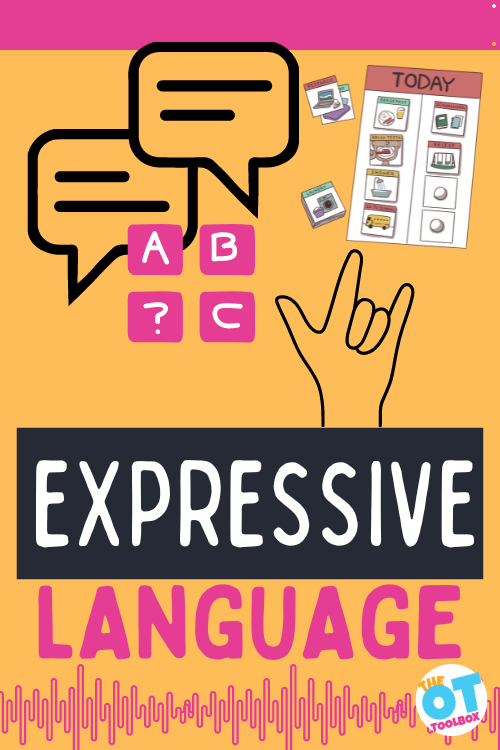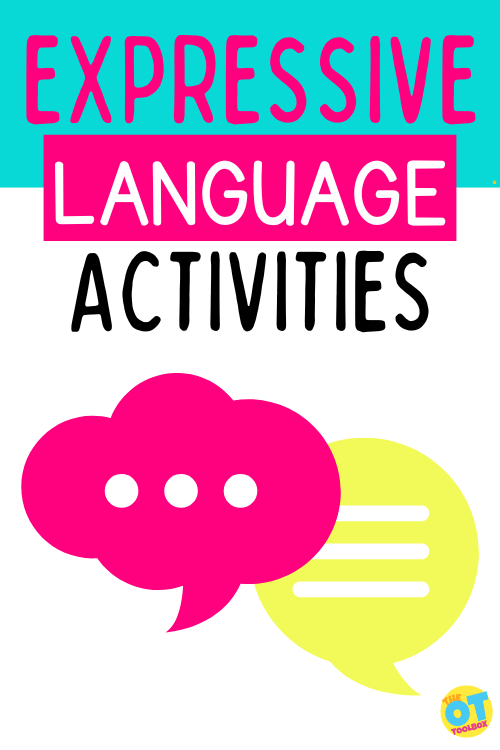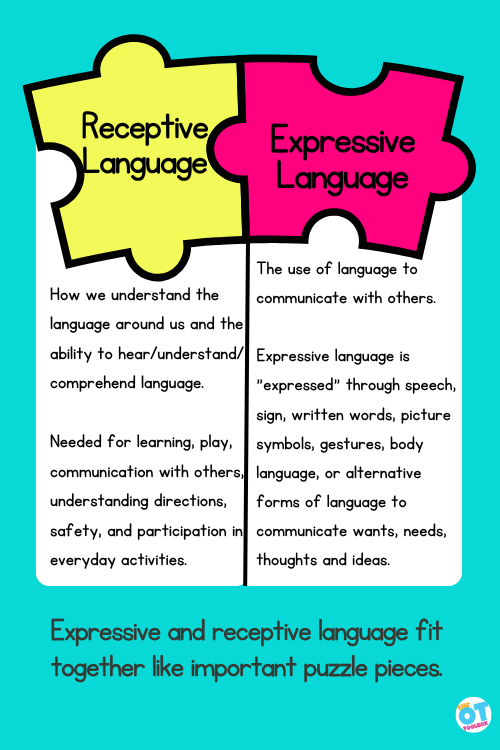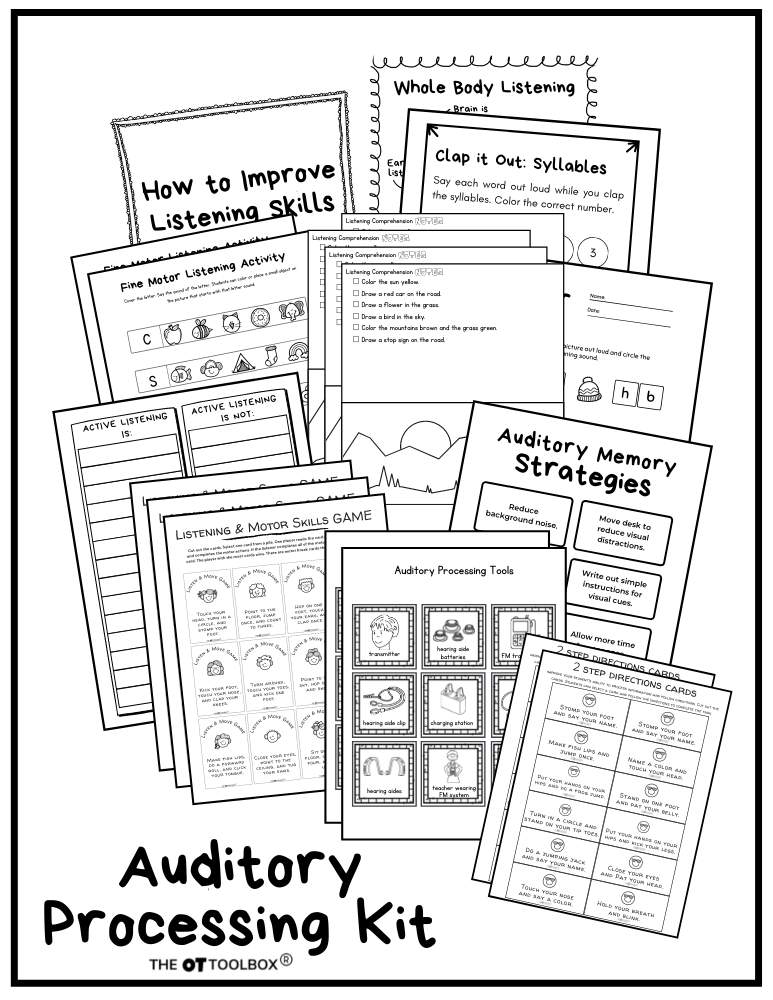This blog discusses the importance of expressive language and how it impacts development, how learning new words directly correlates to a child’s behaviors, and expressive language activities to support infants, toddlers and preschoolers. Let’s go deep on the effect of expressive language development on behavior as well as these other concepts. You’ll see in this blog how communication through visual cues, verbal and gestures impact behavior. Related, is receptive language. Together these language types impact auditory processing and attention and play a huge role in overall language in social skills.

What is Expressive Language
Expressive language refers to how we communicate our thoughts, feelings and desires with others. Expressive language is needed for learning, play, participation in activities and engaging with the world around us. As we develop new ways to communicate (visuals, gestures and spoken words) we are able to get our needs met in a timely fashion.
Expressive Language Development
Expressive language develops through a continuum, beginning at birth.
Babies- As soon as a baby is born, they are able to communicate with others through their whimpers and cries. Mom’s tend to know the difference between an infants “cry for hunger” and the “cry for tired.”
As babies continue to develop their motor skills, they are able to reach for, grab at and point to items they want. These gestures are non-verbal ways to communicate helps others understand what the infant and toddler is requesting. It’s the beginning of functional hand-eye coordination and where we see the beginning of the development of hand-eye coordination.
Toddlers- As infants turn into toddlers, they start to babble, use jargon and eventually imitate words. As children develop, reaching motor, feeding and cognitive milestones, they are able to use a variety of words, to communicate with adults and peers. As they continue to master the sounds in words, more people are able to understand them.
As children reach new ages, they are able to communicate in new ways. According to this article, the following are expressive language milestones that typically developing children reach from birth through age five:
0-3 months
- Your baby smiles at you when you come into view.
- They repeat the same sound a lot and “coos and goos” when content.
- Cries differentiate, meaning that the baby uses a different cry for different situations.
4-6 months
- Gurgling sounds or vocal play occur while you are playing with your baby
- Speech-like babbling includes many sounds including bilabial (two lip) sounds: “p,” “b,” “w” and “m.”
- Uses sounds and gestures to tell you that they want something or want to do something.
7-12 months
- Babbling includes more consonants, as well as long and short vowels.
- They use speech or other sounds (other than crying) in order to get your attention and hold on to it.
- Single words start to emerge like: “mama,” “byebye,” “no.”
1-2 years
- Uses one to two word phrases like “where ball?”, “what that?”, “more cookie?”, and combine two words in other ways to make a variety of statements. Words become clearer as more initial consonants are used.
- 18 month olds typically have 15-20 words.
- 24 month olds typically have 50-75 words.
2-3 years
- Utterances are often one, two or three words long and family members can usually understand them.
- Every week they gain more words.
- By the time they are 3, children typically have 300-500 words.
3-4 years
- Sentences are becoming longer as your child can now combine four or more words.
- They talk about things that have happened away from home and are interested in talking about pre-school, friends, outings and interesting experiences.
- Speech is usually fluent and clear and other people can understand most of what your child says.
4-5 years
- Children speak clearly and fluently in an easy-to-listen-to voice.
- They can construct long and detailed sentences (e.g., “We went to the zoo but we had to come home early because mommy hurt her foot”).
Older children- As children start to use more words and string words together to form sentences, they may be hard to understand. This is called the intelligibility of speech sounds.
As children articulate words, they may make some errors, such as forgetting some sounds in words, omitting the sounds off the beginning or ending of words, and sometimes leaving out sounds in the middle of words (like “elphant” instead of “elephant”).
As children continue to practice words, they become easier to understand. Different letter sounds develop at different ages, so sometimes you will hear children use certain sounds in the place of others. Here is an awesome sound development checklist from Kid Sense Child Development Site:
“0-6 ms:
- The baby makes cooing sounds (e.g. ‘oo’, ‘ee’, ‘ah’), turns towards sounds and gives eye contact when they hear an adult speaking or making sounds
6-12ms
- At 6 months the baby starts
to babble and repeat sounds (e.g. ‘mamama’)
1-2 years
- The child is able to say
the following sounds in words- /p/, /b/, /m/, /n/, /t/, /d/ - The child is able to say
the following sounds in words – /p/, /b/, /m/, /n/, /t/, /d/
2-3 years
- The child is able to say the following sounds in words- /p/, /b/, /m/, /n/, /t/, /d/
- The child is able to say the following sounds in words – /p/, /b/, /m/, /n/, /t/, /d/
3-4 years
- The child is able to say the following sounds in words – /p/, /b/, /m/, /n/, /t/, /d/, /k/, /g/, /f/, /s/, /y/, /h/
- Speech may be unclear to adults who don’t know the child well
4-5 years:
- The child is able to say
the following sounds in words – /p/, /b/, /m/, /n/, /t/, /d/, /k/, /g/, /f/,
/s/, /y/, /h/, ‘sh’, ‘ch’, ‘j’, /z/, /l/, /v/
5-6 years
- Speech should be mostly
clear and easy to understand, but some immaturities may still be noted(e.g. with ‘r’ and ‘th’ sounds)”
If you have concerns about your child’s development, or want to confirm they are on track in developing their early speech sounds, this website from National Institute on Deafness and Other Communication Disorders includes an early communication checklist from birth through age five.
After completing the checklist, if you still have concerns and your child is younger than 3, seek out the Early Intervention Program in your area. This program evaluates and supports children with developmental delays in language, cognitive, motor, self help and self care areas of development.
If your child is older than 3, please speak to your child’s pediatrician or your local school district to request a speech evaluation.

Expressive Language Activities
Here are five simple ways to ensure your kids are learning new words:
1.Use visuals.
When you are looking through books, have your child point to pictures in the book and say label them. If they don’t know the word, you can say it. As they grow, add in more descriptive words (ex big red car.)
Resources like visual schedules are support tools in daily functional tasks.
2.Narrate play.
As children are playing different games, describe what they are doing using a variety of words. For example, “You are pushing that red truck down the ramp. It is going so fast. Oh no, it flipped over!” As children hear you describe what is happening, they are learning new words in real time and understand how multiple words can be put together. This includes using past tense, present tense, plurals and more.
3.Give your child time to imitate new words.
If your child is having a hard time saying a word, repeat it once then wait for thirty seconds to see if they are able to repeat it back to you.
The wait period works for non-verbal situations, as well. You can engage with a child and follow their lead in a non-verbal conversation through play. This is a piece of the DIR Floortime play strategy where time is given for response.
4. Sing songs that include hand motions.
Gestures are a huge part of communication. When you sing songs that include fingerplays, children learn new gestures as they are hearing new words. This allows children to fall back to using the gesture if they need to. Some great gestures to include is “stop” “up” down” “happy” and “sad.” Find some great nursery rhymes and other rhymes with hand motions and some wonderful finger songs that children love. Hand clapping games are another way to foster engagement through movement and rhyme.
5. When children are young, start introducing basic sign language.
Early ASL is a wonderful way to help infants and toddlers communicate as they develop their verbal sounds. Some popular early ASL sings include “more,” “all done,” “eat,” and “help.”
We have several sign language resources and tools available inside The OT Toolbox Members Club.
Expressive Language and Tantrums
Sometimes tantrums occur due to inability to communicate effectively. We’ve covered this in our resource on determining the difference between a tantrum and a meltdown.
The thing to consider is that when expressive language, or the inability to express ones needs or desires through oral language leads to a breakdown of some kind, it is itself, a sensory issue, as the ability to utilize sounds effectively is part of the olfactory sensory system.
There are many reasons why preschoolers become upset or throw a tantrum. Sometimes it is due to not having the words to communicate their wants to needs in the moment.
It takes a lot of time for children to think of a word and say it, especially if they are feeling frustrated, overwhelmed, hungry or tired. When they are upset, overwhelmed and uncooperative, give them the tools to settle down.
Once a child has calmed down, support them by helping them find the words they are looking for to tell your or the other child what they are feeling and what they need from them.
This could include phrases such as “I want a turn; I need space; I’m tired; or I need help” When you determine which phrase they are struggling with using, practice that phrase throughout the days and weeks ahead, so they are able to recall it next time they become overwhelmed.
Other strategies may include:

expressive language Impacts Development
Just like receptive language, expressive language impacts a variety of areas of child development. As teachers and parents, when we slow down and support expressive language skills, all other areas of a child’s life will benefit.
As early as birth, singing, talking and reading to children help develop neuron and synapses development in the brain.
Encourage your children to take part in a variety of play based language activities that support imitation, gestural communication, visual supports and language recall. As children develop new skills and have exciting opportunities to practice the language skills they know, they will be able to communicate with the world and others will be able to understand them. If your child is struggling with new speech sounds or developing new words, seek out language help early to give your child guidance and support needed to master language.
Don’t forget to check out all of the great resources on the OT Toolbox, including the Auditory Processing Tool Kit.
The resources support listening skills, auditory memory strategies, and includes games and activities to foster auditory processing during functional tasks.
Get your copy of the Auditory Processing Kit here.


Jeana Kinne is a veteran preschool teacher and director. She has over 20 years of experience in the Early Childhood Education field. Her Bachelors Degree is in Child Development and her Masters Degree is in Early Childhood Education. She has spent over 10 years as a coach, working with Parents and Preschool Teachers, and another 10 years working with infants and toddlers with special needs. She is also the author of the “Sammy the Golden Dog” series, teaching children important skills through play.






